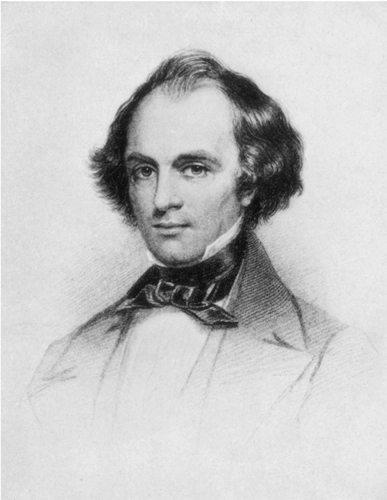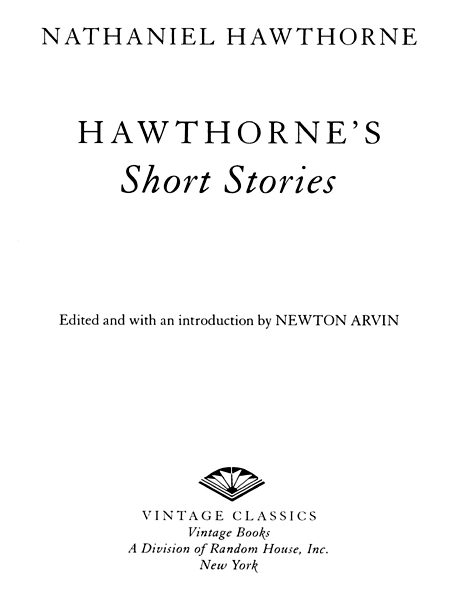Hawthorne's Short Stories
NATHANIEL HAWTHORNE
Short Stories
Nathaniel Hawthorne (1805–64) was an American novelist and short-story writer. He was born in Salem, Massachusetts, and graduated from Bowdoin College. His first novel, Fanshawe, was published anonymously in 1828, followed by several collections of short stories, including Twice-Told Tales and Mosses from an Old Manse. His later novels include The Scarlet Letter, The House of the Seven Gables, The Blithedale Romance, and The Marble Faun.
Newton Arvin (1900–63) was a literary critic and professor at Smith College known for his influential writings about nineteenth-century American literature. He is the author of biographies of Nathaniel Hawthorne and Walt Whitman, and his biography of Herman Melville won the National Book Award in 1951.

NATHANIEL HAWTHORNE AT 46
From an engraving of a portrait by C. G. Thompson

FIRST VINTAGE CLASSICS EDITION, JANUARY 2011
Copyright © 1946 and renewed 1973 by Alfred A. Knopf, Inc.
All rights reserved. Published in the United States by Vintage Books, a division of Random House, Inc., New York, and in Canada by Random House of Canada Limited, Toronto. Originally published in hardcover in the United States by Alfred A. Knopf, Inc., New York, in 1946 and subsequently in paperback by Vintage Books, a division of Random House Inc., New York, in 1955.
Vintage is a registered trademark and Vintage Classics and colophon are trademarks of Random House, Inc.
This is a work of fiction. Names, characters, places, and incidents either are the product of the author’s imagination or are used fictitiously. Any resemblance to actual persons, living or dead, events, or locales is entirely coincidental.
The Library of Congress has cataloged the Knopf edition as follows:
Hawthorne, Nathaniel.
Short stories / Nathaniel Hawthorne.
New York, Knopf, 1946.
I. Arvin, Newton, 1900–1963, ed.
p. cm.
PZ3.H318 Sh PS1852
46003911
eISBN: 978-0-307-74279-7
www.vintagebooks.com
Cover design by Megan Wilson. Cover painting by Claude Aubriet c.1670 © V&A Images
v3.1
CHRONOLOGY
1832
“The Gentle Boy” and “The Wives of the Dead” in the Token.
1835
“The Gray Champion,” “Young Goodman Brown,” “The Ambitious Guest,” “Wakefield,” and “The White Old Maid” in the New-England Magazine. “Alice Doane’s Appeal” in the Token.
1836
“The Minister’s Black Veil” and “The Maypole of Merry Mount” in the Token.
1837
“The Great Carbuncle” and “The Prophetic Pictures” in the Token. “Dr. Heidegger’s Experiment” in the Salem Gazette.
1838
“Peter Goldthwaite’s Treasure” and “Endicott and the Red Cross” in the Token. “Lady Eleanore’s Mantle” in the Democratic Review.
1839
“Old Esther Dudley” in the Democratic Review.
1843
“Egotism; or, The Bosom Serpent” and “The Celestial Railroad” in the Democratic Review. “The Antique Ring” in Sargent’s New Monthly Magazine. “The Birthmark” in the Pioneer.
1844
“The Christmas Banquet,” “The Artist of the Beautiful,” and “Rappaccini’s Daughter” in the Democratic Review. “Earth’s Holocaust” in Graham’s Magazine. “Drowne’s Wooden Image” in Godey’s Magazine and Lady’s Book.
1850
“The Great Stone Face” in the National Era.
1851
“Ethan Brand” in the Dollar Magazine.
1852
“Feathertop” in the International Magazine.
INTRODUCTION
IF HAWTHORNE had died in his middle forties—an advanced age for a man of genius—we should know him now not as the author of The Scarlet Letter or any of his other novels but solely as a writer of short stories or tales. It is true that, two or three years after he left college, Hawthorne had written and published anonymously a little novel called Fanshawe, which under different auspices might well have been followed shortly by other works of fiction on the same scale—and of richer substance—but some chill in the New England air at that early hour disheartened the young Hawthorne for novel-writing, and in fact he had destroyed all the copies of Fanshawe itself that he could lay hands on. It had been a pretty unripe little work at best, and in any case for twenty years thereafter Hawthorne stuck consistently to the briefer form. By good luck it was admirably suited, all that while, to what he had to say, as it was to what Hoffmann and Gogol and Gautier had to say at much the same time, and the best of Hawthorne’s tales express his nature, his personal sense of things, so subtly and truly that there can be no question of loss or limitation.
No literary fame, however, was ever of slower or less sensational growth. Hawthorne himself, who had been born in 1804, once said that for many years he had been the obscurest man of letters in America, and this remark hardly exaggerated the facts. For a long time his audience had been limited to the readers of the modish little “gift-books” or annuals, and even in those genteel pages he was anonymous and unidentifiable. A deep-rooted shyness had kept him from signing his contributions to the Token, as the best of the annuals was called, and for years he had hidden behind the mask of “Ashley Allen Royce” or “The Author of ‘The Gentle Boy.’ ” Such work as his, however, could not fail indefinitely to make its impression, and a handful of readers had already been puzzling over the secret of its authorship when, in 1836, Park Benjamin, an astute and friendly journalist, named him by his real name—and eulogized him—in a popular magazine.
A year later Hawthorne was persuaded by a friend to make a collection of his pieces in book form, and the Twice-Told Tales appeared over the imprint of a Boston publisher.
1 comment